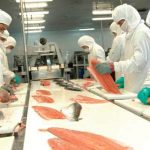Food power
The food industry is one of most dynamic sectors of Chile’s economy representing around 24% of its GDP.
Chile˙s food exports have grown at an average annual rate of 10% over the past ten years, making it the world’s fastest-growing food exporter. By 2010 exports had risen to more than $11.6 billion compared to $5 billion in 2002. The Chilean food industry now employs more than a million people, representing around 20% of the country’s workforce and providing 174 countries with premium fresh and processed food products.
“Agriculture is one of the engines of the Chilean economy,” says Juan Pablo Matte, Secretary General of Sociedad Nacional de Agricultura (SNA), the agricultural association. “Our agro-industry is no longer content with the mere export of natural resources. There is a new dynamism with regards to adding value to these products, and moving beyond being just a commodities exporter.”
If Chile is successful in its bid to become a food power, it will be among the world’s ten largest food exporters (including the U.S., France, Belgium, Germany, Holland, Canada, China, Spain, Italy and Australia). This would be an important jump from its current 17th position and would mean food exports of $250 billion by 2015. Projections suggest that in the future exports will reach $62 billion by 2030 and the sector will account for more than 35% of Chile’s GDP, employing one in three workers.
 Chile is a leading producer and exporter of some of the world’s finest fruits, berries, vegetables, fish, shellfish, poultry, meats and premium wines. It is the world’s largest exporter of fresh grapes (29%), plums (23%), and fresh fish fillets (22%). It is the world’s second largest exporter of frozen pacific salmon (30%), avocados (16%), and other frozen fish (10%). And it is the world’s fifth largest exporter of wine (5%) and frozen pork meat (5%).
Chile is a leading producer and exporter of some of the world’s finest fruits, berries, vegetables, fish, shellfish, poultry, meats and premium wines. It is the world’s largest exporter of fresh grapes (29%), plums (23%), and fresh fish fillets (22%). It is the world’s second largest exporter of frozen pacific salmon (30%), avocados (16%), and other frozen fish (10%). And it is the world’s fifth largest exporter of wine (5%) and frozen pork meat (5%).
The area cultivated for fruit has increased from 221,000 to 265,000 hectares over the 2004 to 2009 period, representing an increase of almost 20%. However, the share of cultivated land devoted to subsistence crops (such as wheat and maize) has seen a substantial drop in acreage, although they still have the largest number of hectares in cultivation. As a result, wheat imports have grown four-fold since 2004. Beef is also a large import item, about 100,000 tons each year.
Chilean foods win awards for their taste and quality in international food competitions. For example, Chilean olive oils have garnered international acclaim at competitions including the Leone D’Oro dei Mastri Oleari 2006, Parma, Italia, and the Sol d’Oro 2006, Diploma di Gran Menzione. In addition, a Chilean cheese received the American Cheese Society award, while Chilean lamb was recognized as the Best Organic Product from ANUGA.
Favorable conditions
Chile’s prodigious food production is the result of the convergence of several factors.
“Chile still has vast untapped agricultural potential,” Matte says. “We have four important competitive advantages.”
 First, Chile is 4,300 kilometers long and extremely narrow, creating a diverse geography and unsurpassed climatic range and soils that are suitable for growing a wide range of foods. The mild, Mediterranean-style climate of Chile’s central region is ideal for growing fine-quality fruits and vegetables, both traditional as well as exotic varieties, which the country exports to 70 markets.
First, Chile is 4,300 kilometers long and extremely narrow, creating a diverse geography and unsurpassed climatic range and soils that are suitable for growing a wide range of foods. The mild, Mediterranean-style climate of Chile’s central region is ideal for growing fine-quality fruits and vegetables, both traditional as well as exotic varieties, which the country exports to 70 markets.
As a southern-hemisphere country, Chile also has off-season production, which means its produce does not compete with European or American produce during their peak seasons. Chile can thus supply the fresh fruits and vegetables to northern hemisphere countries during their winter months.
Moreover, the protective natural barriers of ocean, high mountains, desert and glaciers have protected Chile’s meat (pork, lamb, and beef) and poultry industries from the parasites and diseases common to most other countries. Chile has never experienced any known cases of avian flu or mad cow disease. In addition, Chile is free from all animal diseases registered on List A of the World Organization for Animal Health (OIE).
Lastly, Chile has a network of trading arrangements with 58 countries meaning Chilean producers have preferential tariff access to markets that represent over 80% of global GDP and almost half the world˙s population. And by 2012, 74% of Chilean agribusiness exports will be duty free.
For more information:
Ministry of Agriculture
Sociedad Nacional de Agricultura
Chilealimentos
Unbeatable climate
Chile’s climate and geography was the main attraction for Pioneer, a world leader in the development of agricultural biotechnology and the production and sale of seeds.
Located in the Azapa Valley in the Arica Region in northern Chile, Pioneer’s Experimental Agroindustrial Station specializes in the development of corn seed hybrids, soybeans and canola.
“The unbeatable natural and climatic conditions of the Azapa Valley make it a unique place for the development of specialized agriculture and seed research. Together with the important support of CORFO, this made us decide on Arica to set up one of Pioneer’s most important centers in the world,” says German Alessandri, External Affairs Manager for Semillas Pioneer Chile.
Pioneer, a subsidiary of the U.S. chemical company DuPont, chose Arica for the research center because of the region’s natural advantages, such as its year-round dry climate and the fact that the valley is isolated from the country’s agricultural zone.
And because Chile is in the southern hemisphere, Pioneer can take advantage of the months in which the northern hemisphere is in winter. This extends the total number of months in which continuous research can be made to nearly nine months a year. This means costs savings and longer research time.
The CORFO-InvestChile program provided Pioneer with guidance during the evaluation and development of the business, assistance in collecting information, and granted financial incentives to the company for project development.
Pioneer employees 96 employees permanently and 210 temporarily including professional researchers and technicians in the area.



